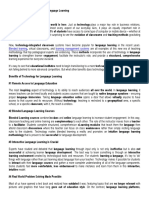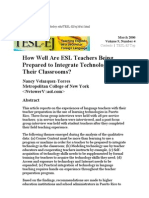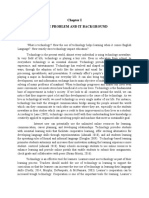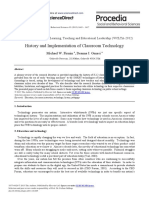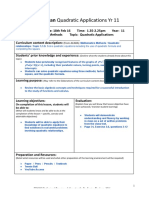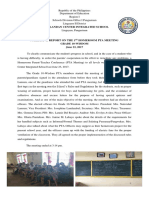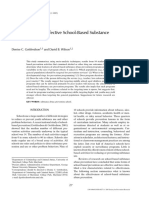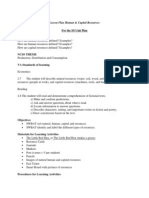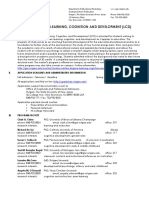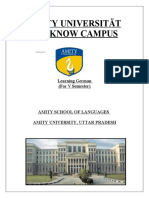Pablo A.
Serna
Infusing Multiple Technologies into a Foreign Language Teacher Education Program
Within the 2009 Report of the Central States Conference on the Teaching of Foreign Languages (CSCTFL) there is an article that shares some details about the factors that help including technology as one of the main tools in a foreign language teaching curriculum. Also this article mentions some barriers that interfere with placing technology at the level that it should have, if we take into consideration the increasing level of technology use in everyday situations. Throughout this paper I will make comments while highlighting the main ideas of the article. People worldwide are having easier access to technology and resources are becoming unlimited in reference to authentic material that can be used to create a better grasp of different cultures through comparisons, understanding practices in our communities, etc. According to the United States Department of Educations Office of Educational Technology, statistics acquired between 2000 and 2002 show an overwhelming increase of internet users, having children between 2 and 5 year olds as the largest new group, and 90 percent of children between 5 and 17 use computers (p. 17). Prensky (2008) has divided people between digital natives and digital immigrants. That division reflects the capacity to learn through multimedia (audio, video, print). Natives navigate through technology like fish in the sea and they learn using those means. Immigrants on the other hand, must adjust to technology so they do not stay behind.
�One of the first limitations to include technology as an important part in a lesson design is that it cannot be assumed that all teachers have the knowledge and/or capacity to include technology in their lessons. Planning, instructing, and assessing using technology have encountered several difficulties to be put into practice: 1) Teachers think the way they learn is the best way to teach. 2) They may be digital immigrants themselves. 3) They are not well trained by universities or schools. 4) There is no motivation to acquire technology skills, or put them into practice, because of a lack of reward systems, and 5) Money. The first reason demonstrates how some instructors think people learn the same way they learned 40 years ago and we know the paradigm shift wont occur in a short period of time. Old methods are still applied and students do not develop a knowledge that could provide a better understanding of the world outside their own world. The impossibility to access a communicative way of learning puts limits to the capacity to express ideas in the target language. Research has shown that inside a classroom there are as many ways of learning as many students there are in the classroom and one method that does not allow communication will not help to reach communicative goals and will fail when motivation and excitement is required, and the affective filter will be as tall as the wall in the classroom the instructor is teaching in. The second reason shows that teachers that do not use technology in their own lives, and just the idea of having to use it to teach causes headaches, will not explore new resources and tools like the internet and computer software, at least at the beginning, producing a dramatic technological shock inside students that are
�accustomed to a virtual way to see life and education. I am not saying that technology is the only way to teach but resources are limited without it. Older teachers did a great job without the advantages that the modern technologies have provided us but there is no reason to keep a limited room for closing our eyes to a whole new concept of authenticity, global communications and access to a world that was hard to explore without something as easy as Google. In connection to the third reason, university and/or school training, the article emphasizes the need to have leaders that know the complexity of effective technology integration (Strudler & Wetzel, 1999, p. 68) (Strudler & Wetzel, 1999, p. 68), and that these leaders need to provide specific training to instructors, and not only a 3-hour workshop that will not present enough means to include technology in lesson planning. If teachers are not prepared, active learning will not be available for students to build up their communicative skills. If teachers and students are tuned the same way in their expertise of technology it will cause a better connection between the two and the course will be a scenario of production and not a cheap stage of repetition. Reason number 4 discusses the lack of reward systems for instructors that have seen the usefulness of technology and the endless amount of material that can be accessed to create an environment that fulfills the Standards that foreign language teaching sets as goals through a communicative way of teaching and learning. It is well known that money is one of the main reasons why a lot of strategies, projects, etc. are not doable. This shortage of money affects not only the reward systems that could provide extra motivation to teachers that would like to have the
�chance to be promoted or have a salary increase because of their abilities and skills, but also affects the possibility to buy the electronic devices that are needed in schools and universities to access the wonders of the modern world. The article explains widely how different methods and technologies have been used at the University of Arkansas at Little Rock. Tools like Blackboard, iClicker, MP3, video, etc. plus a curriculum that offers courses that involve technology use like developing a e-portfolio for each student, creating profiles in virtual social networks, etc., have shown the great value that technology, pedagogy of the discipline and a well prepared teacher can offer. Socio-cultural courses, foreign language courses and online courses that give students instruction on the use of software and hardware to produce projects are put together with an eye-opening, open-minded, rich method to teach and learn. In my opinion, the article is very useful to understand how technology and well prepared teachers can improve the setting for a communicative course that will provide a variety of resources for teachers and students. When there is a goal and all forces are pushing to the same side, the success will be overwhelming at the end. But when the situations explained before interfere with this vision, the paradigm shift from old to new methods, theories, etc. will take longer than expected. Technology is not the teacher and definitely it is not the only way to create a lesson plan, but it has expanded our horizons to a new and accessible way to understand who we are, who the others are, and how we interact in our communities.
�We have to be careful with the use of technology because the world has been opened to our eyes, but our private lives can be opened to the sight of the world also. So, when the article describes how students have to create a virtual profile in a social network, I hesitate implementing this type of activity because of privacy implications. As instructors, we have a huge responsibility to provide a safe environment for our students, and with technology, our classrooms have expanded beyond the walls. I really enjoy the use of technology but I have learned that relying just on technology is not beneficial. A simple power outage can makes us look like fools without a backup plan, and to have a backup plan, we need to be prepared and have a lesson plan that equally fulfills the goals we have set because students expect the best from us and that is the least we can give them.
�Works Cited
Dhonau, S., & McAlpine, D. (2009). Infusing Multiple Technologies into a Foreign Language Teacher Education Program. Richmond, VA: Robert M. Terry, 55-67 Prensky, M. (2008, September 25). Mark Prensky.com. Retrieved from Digital natives, digital immigrants. On the Horizon, 9(5), 1-6.: http://www.marcprensky.com/writing/Prensky%20%20Digital%20Natives,%20Digital%20Immigrants%20-%20Part1.pdf Strudler, N., & Wetzel, K. (1999). Lessons from exemplary colleges of education: Factors affecting technology in education. Educational Technology Research and Development, 47(4), 63-81. Educational Technology Research and Development , 6381. Technology, U. S. (2004). Toward a new golden age in American education: How the internet, the law and today's students are revolutionazing expectations. Washington D.C.: U.S. Government Printing Office.










